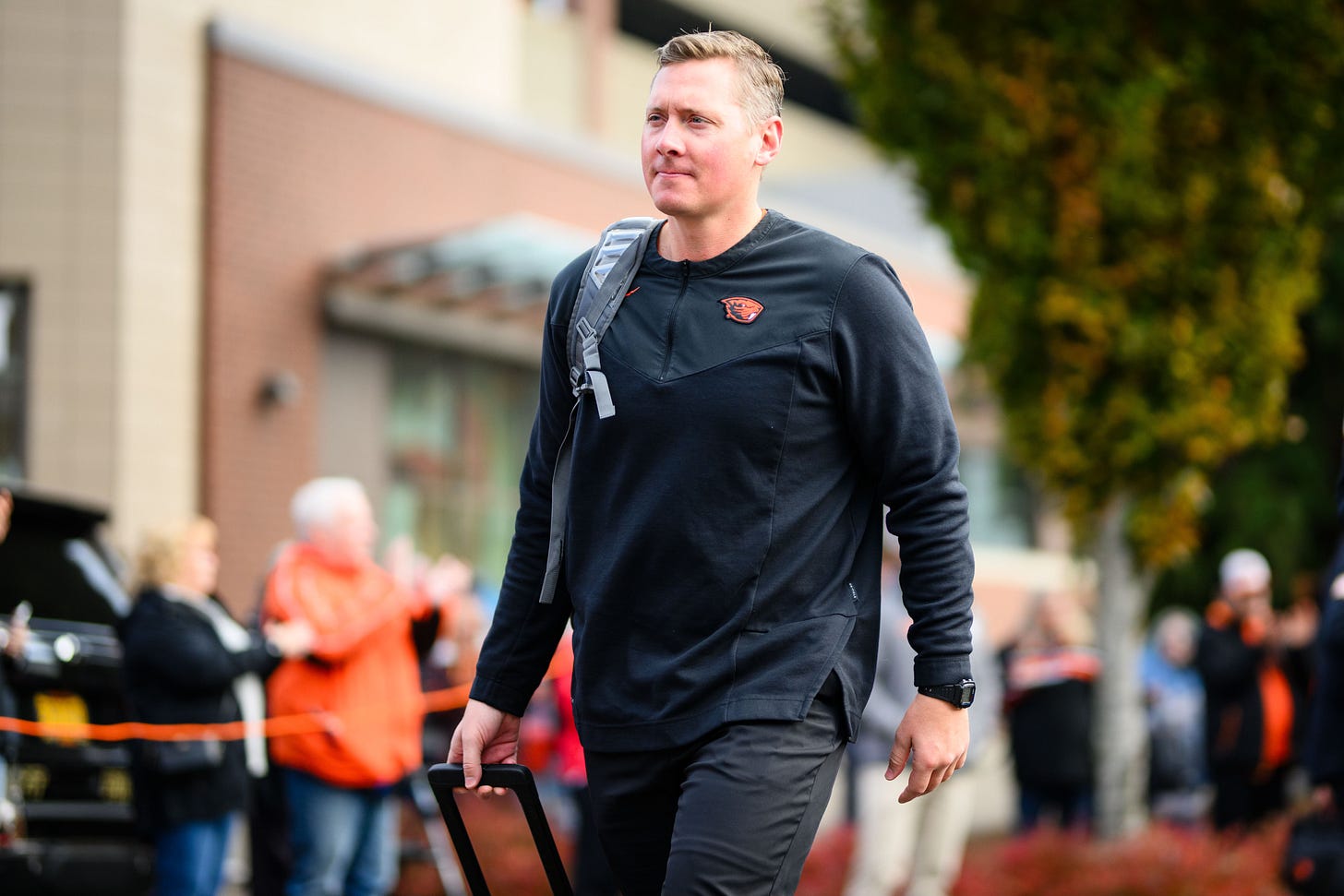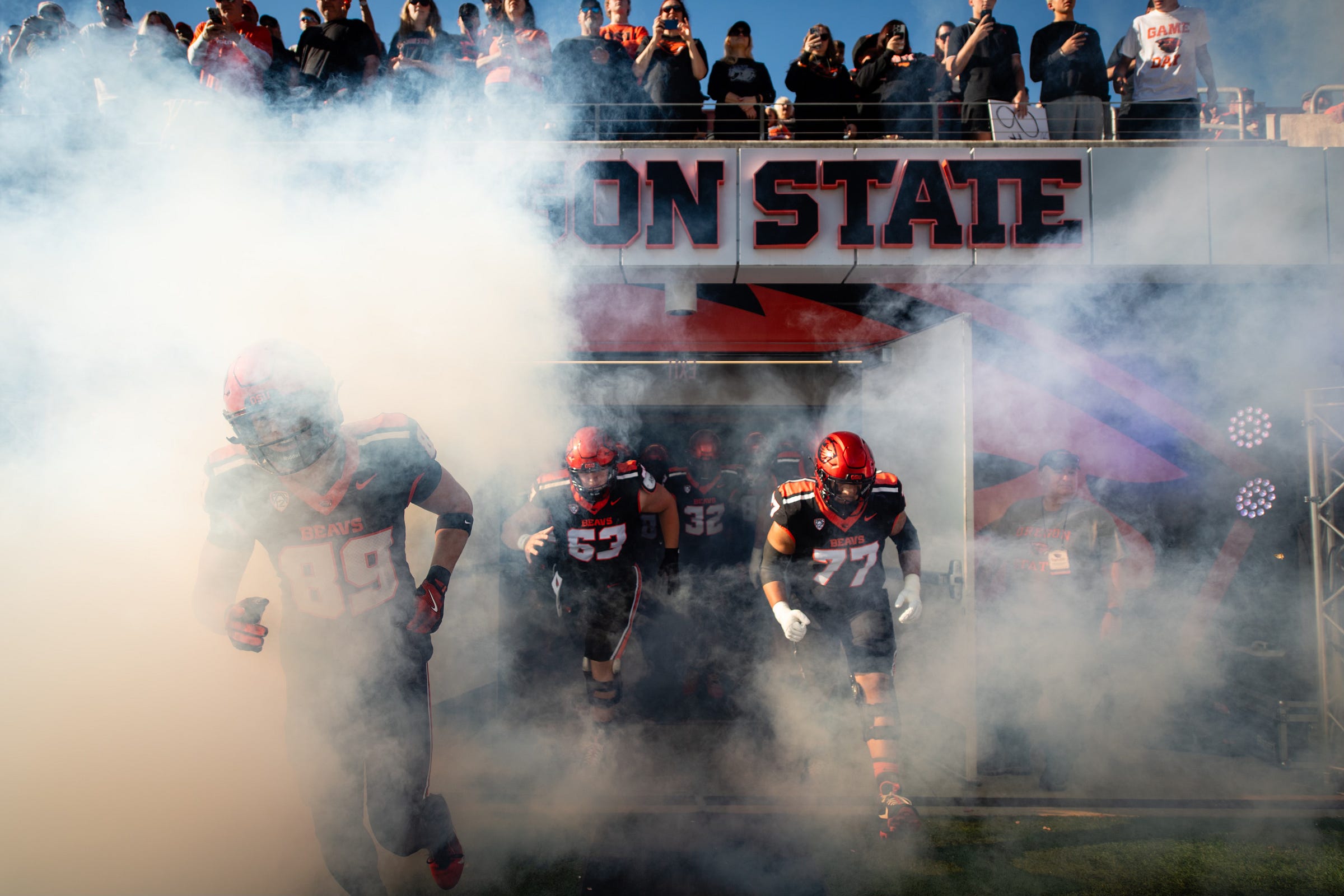Canzano: Is the smoke lifting for Pac-12?
Oregon State AD: "Exposure is super important."
Scott Barnes struck an upbeat tone this week. And why not? The Pac-12 announced a media rights deal that puts Oregon State’s football team on ESPN twice next season.
“What you get with ESPN is this engine, this marketing engine that goes way beyond the broadcast of the game,” Barnes, the OSU athletic director, told me. “It’s the promotional aspects during SportsCenter and other pieces as they lead up to the game, and then following up after the game. So all that combined is a really important part of what we’re trying to do.”
The Pac-12 is a two-member conference in 2025. It sold 13 combined football games to ESPN (two games), The CW (nine games), and CBS (two games). OSU and Washington State got the TV exposure they coveted. But what happens in 2026 and beyond?
That’s become the question to ask. The TV deal for the new-look conference is bound to include some of the same partners, right? Also, there’s a looming expansion question. One more school? Or two? Or three?
The new-look Pac-12 presidents met in person this week at the conference’s Bay Area headquarters. The conference ADs also convened there.
What’s the timeline?
Anything Barnes can share?
“Yeah, you know, I can’t,” he said. “Can’t comment on that. I wouldn’t tell you that it is or isn’t. What I will tell you is that I’m really excited about the progress that’s been made on 2026 and beyond. And, you know, we’re getting closer by the day, so that’s yet to be determined on the timing. But like our progress.”
The CW and CBS are available in 100 percent of U.S. households. 11 of the 13 football games for OSU and WSU next season will appear on those two networks. ESPN will air a pair of 7:30 p.m. kickoffs in the Pacific Time Zone.
Media deals are always a blend of exposure vs. revenue. The Pac-12 schools need money, for sure, but what they needed more than anything was not to disappear.
“If the amount of revenue could solve all my problems, I’d say let’s just take the revenue and not worry about anything else,” Barnes said. “But obviously, in this case, we need both. But as you think about our trajectory, you think about this rebuild and this launch that’s going to take place a year from July 1, that exposure is super important. It becomes a catalyst for our future. It really does. So we’re happy with the distribution that we have among the three partners.”
Kickoff times for the Pac-12 home football games were also announced this week. The inability to make travel plans for home games was a chronic source of frustration in recent years, particularly when kickoff times weren’t released until six or 12 days before games. Will set times be part of the 2026 deal?
Said Barnes: “I think it’s something that we would want to continue to pursue. Moving into 2026 and beyond as well is to have those windows locked down and the times where we can really be advantageous for us and our fans.”
Boise State is knee-deep in a $65 million football stadium renovation that will be ready for its first Pac-12 game in 2026. This week, the Broncos gave football coach Spencer Danielson a five-year, $11 million contract that runs through the 2029 season.

Oregon State is also being obvious about its investment in football. Head coach Trent Bray’s contract pays him $2 million a year, putting Bray and Danielson on the top end of the new-world Pac-12 scale. The Beavers signed transfer quarterback Maalik Murphy through the portal, using a $1.5 million NIL package that includes additional incentives, per sources. The collective also spent a combined $500,000 on a pair of tight end transfers.
“End of the day, from a media rights perspective, (football) drives 80 percent to 90 percent of your revenue from an overall athletic department, (and) you’re talking about 75 percent of your overall revenue for all your programs,” Barnes said. “So, yes, it’s critical. It’s an engine that creates opportunities across all of our sports programs.”
That said, Oregon State’s AD called the transfer portal “an absolute trainwreck.” And said there was “a nonsensical hyperinflation” in the NIL market in men’s basketball in the last cycle. It was driven, Barnes said, by the looming House v. NCAA settlement, which comes with restrictions.
“Everybody was getting to the finish line to get new deals in before the new system is in place,” he said. “Because once the new system is in place, the enforcement arm, the clearinghouse, the cap management systems, it’s going to be different. There’s going to be a leveling off of these crazy deals… and oh, by the way, it’s got to be legitimate NIL activity. So the dollars are going to come down.”
Will there be enough oversight and enforcement of the new rules?
“This is not the NCAA,” Barnes said. “This is a separate entity with professional enforcement staff. Nimble, small, autonomous decision making, and a big stick. Penalties that will absolutely hurt. Look, this is imperfect, right? Nothing’s going to be perfect. But this enforcement arm is completely different than anything you’ve seen at the NCAA level.”
Ohio State, Texas, Oregon, and others are loaded with talent and operating with revenue streams and budgets that dwarf most of the programs from the ACC, Big 12, and obviously, the new-look Pac-12. Will the revenue-sharing cap and new NIL rules help other schools close the gap on the top-spending schools in the Big Ten and SEC?
Barnes said. “If there weren’t a cap, that gap would never be closed. It would never be even shrunk. And so there is that.”
Campus leaders at OSU and WSU joined the presidents and ADs from Gonzaga, Boise State, San Diego State, Colorado State, Fresno State, and Utah State for a two-day retreat at the Pac-12 facility in San Ramon, Calif., this week.
The two Pac-12 legacy member schools that fought for survival in a Whitman County courtroom in late 2023 were now physically in the room with six new member schools, discussing conference business.
“It was so fun,” Barnes said. “The move away from the conceptual, strategic, visionary conversations to actual operational items like scheduling and officiating bowl games. And that brought to me a sense of reality of what we can look forward to. This has come together again. We’re almost just a year away here in July, of pressing ‘go’ on this new rebuild, and so super gratified, so thankful that we’re able to get to the place we are.”



That last paragraph, John? Lovely.
Amazing to think of what they've accomplished from the very depths of ashes. It's not perfect, but it's incredibly more than what seemed possible at those lowest moments.
Well done, OSU and WSU leadership.
Too much money being paid to kids with only high school resumes and a system where only the wealthiest schools have any real shot at winning is a disaster for college athletics.
With the high costs of tuition, books and housing, why isn’t that still enough?
Athletes always get the best dorms, the best food, the best tutors and the opportunity to choose their classes before the non-athlete students. Athletes have always gotten the better deal. What would have been wrong with giving them $1500 a month and call it good?
Other students have to take “real” jobs for money. And are expected to go to school since they are actually paying out their own money for their education. WTF!!!